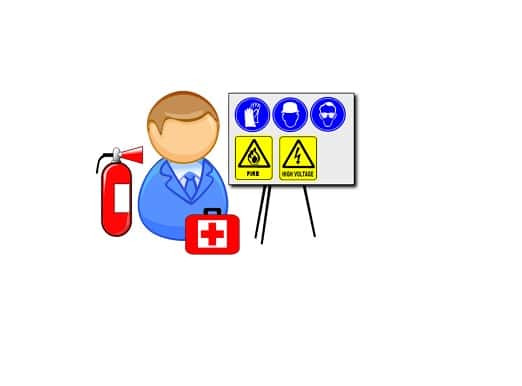Ensuring a safe work environment is paramount for any organization. Identifying and mitigating safety hazards protects employees from harm, fosters productivity, and reduces the risk of costly accidents. From manufacturing plants to office spaces, every facility presents unique challenges when it comes to safety. In this blog, we’ll delve into the top 10 safety hazards commonly found in various facilities, equipping you with the knowledge to create a safer workplace environment.

- Slips, Trips, and Falls:
Slips, trips, and falls are among the most common workplace accidents, leading to injuries ranging from minor bruises to severe fractures. Factors contributing to these incidents include wet floors, cluttered walkways, uneven surfaces, and inadequate lighting. Regular maintenance, proper housekeeping, and the installation of anti-slip flooring can significantly reduce the risk of such accidents.
- Chemical Hazards:
Facilities handling chemicals, whether in the form of cleaning agents, industrial solvents, or hazardous materials, pose inherent risks to employees’ health and safety. Exposure to toxic substances can lead to respiratory problems, skin irritation, or even long-term health issues. Proper labeling, storage procedures, and adequate personal protective equipment (PPE) are crucial in mitigating chemical hazards.
- Fire Hazards:
Fires can have devastating consequences in any facility, resulting in injuries, property damage, and loss of life. Common fire hazards include faulty electrical wiring, flammable materials, improper storage of combustible substances, and inadequate fire suppression systems. Conducting regular fire drills, maintaining fire extinguishers, and educating employees on fire safety protocols are essential preventive measures.
- Electrical Hazards:
Improper use of electrical equipment and wiring can lead to electric shocks, burns, or even electrocution. Overloaded circuits, damaged cords, and exposed wires are common culprits in electrical accidents. Ensuring proper installation by qualified electricians, conducting routine inspections, and providing training on electrical safety practices can minimize these risks.
- Machinery Accidents:
Facilities equipped with heavy machinery and equipment present a significant risk of injury if not operated correctly. Lack of proper training, inadequate machine guarding, and failure to follow safety protocols can result in crushing injuries, amputations, or fatalities. Regular maintenance, enforcing lockout/tagout procedures, and providing comprehensive training for machine operators are vital in preventing such accidents.
- Falling Objects:
In environments where objects are stored at height or overhead, the risk of falling objects causing injury is substantial. Unsecured loads, improperly stacked materials, and inadequate protective barriers increase the likelihood of accidents involving falling objects. Implementing proper storage procedures, using safety nets or toe boards, and wearing appropriate head protection can mitigate this hazard.
- Confined Spaces:
Working in confined spaces such as tanks, silos, or trenches poses unique safety challenges due to limited ventilation and restricted access. Hazards in confined spaces may include toxic atmospheres, engulfment risks, and the potential for asphyxiation or suffocation. Strict adherence to confined space entry procedures, continuous atmospheric monitoring, and providing adequate ventilation are crucial for ensuring worker safety in these environments.
- Biological Hazards:
Facilities like healthcare settings, laboratories, or food processing plants may encounter biological hazards like bacteria, viruses, or other pathogens. Exposure to these hazards can result in infections, allergic reactions, or other health complications. Implementing proper hygiene practices, providing appropriate PPE, and establishing protocols for handling biohazardous materials are essential preventive measures.
- Noise Exposure:
Prolonged exposure to high noise levels can lead to hearing loss and other auditory problems. Facilities with noisy machinery or operations, such as construction sites, are particularly susceptible to this hazard. Implementing engineering controls such as noise barriers or acoustic insulation, providing hearing protection devices, and conducting regular noise assessments can help mitigate the risks associated with noise exposure.
- Workplace Violence:
Workplace violence, including physical assault, threats, or harassment, poses a significant risk to employee safety and well-being. Factors contributing to workplace violence may include conflicts between employees, disgruntled customers, or external threats. Implementing a zero-tolerance policy for violence and harassment, providing training on conflict resolution and de-escalation techniques, and establishing emergency response protocols are essential for preventing and managing incidents of workplace violence.
Identifying and addressing safety hazards in your facility is crucial for maintaining a secure work environment and protecting the well-being of employees. Organizations can significantly reduce the likelihood of accidents and injuries by being proactive in assessing risks, implementing preventive measures, and providing comprehensive training. Safety hazards can manifest in various forms and environments, so staying vigilant and continuously improving safety practices is key to ensuring a safer workplace for all.
By prioritizing safety, not only do you protect your most valuable asset—your employees—but you also contribute to a culture of responsibility and well-being within your organization. So, take the necessary steps to identify, address, and mitigate safety hazards in your facility, and make safety a top priority in everything you do.
Creating a culture of safety requires ongoing commitment and collaboration from all levels of the organization. Regular safety audits, open communication channels, and encouraging employee involvement in safety initiatives can further enhance safety practices and foster a sense of ownership among employees.
Moreover, staying updated on relevant regulations and industry best practices is essential to ensure compliance and continuously improve safety standards. Investing in employee training and providing resources for ongoing education on safety topics can empower employees to identify hazards proactively and take appropriate actions to mitigate risks.
Lastly, fostering a culture of continuous improvement involves learning from past incidents and near-misses. Establishing mechanisms for reporting and investigating incidents, conducting thorough root-cause analyses, and implementing corrective actions can help prevent similar incidents from occurring in the future.
In conclusion, creating a safe work environment requires proactive measures, ongoing commitment, and a collective effort from everyone in the organization. By addressing the top 10 safety hazards outlined in this blog and prioritizing safety at every level, you can create a workplace where employees feel valued, protected, and empowered to contribute to the organization’s success. Remember, safety is not just a priority—it’s a value that should guide every decision and action in your facility.

